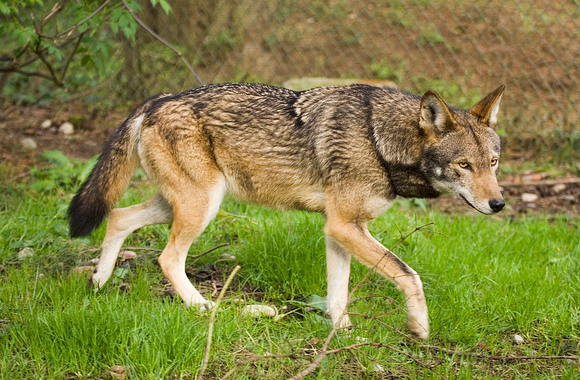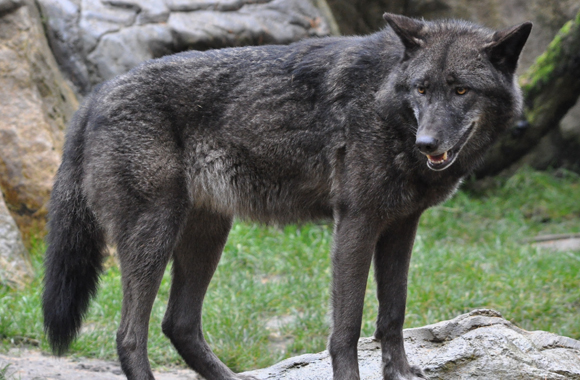Wolves
Born Free works to protect imperiled gray wolves in the U.S. and Ethiopian wolves in Ethiopia from numerous threats that cause critical population declines.
Gray wolf
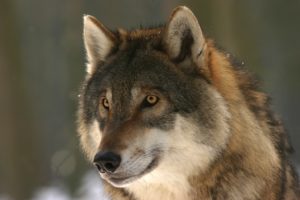 The gray wolf, a keystone predator, is an integral link in the food chain of the ecosystems to which it belongs. Though the gray wolf is the ancestor of the domestic dog, there has been a tragic history of human/wolf conflict. Wolves almost never attack humans and do not generally pose a problem for livestock; however, because they do attack domestic animals, wolves have been hunted relentlessly and were nearly hunted to extinction in the lower 48 states. Some populations survived; some populations have returned to the Great Lakes region, the northern Rockies, and the southwestern U.S.; but the species still faces persecution.
The gray wolf, a keystone predator, is an integral link in the food chain of the ecosystems to which it belongs. Though the gray wolf is the ancestor of the domestic dog, there has been a tragic history of human/wolf conflict. Wolves almost never attack humans and do not generally pose a problem for livestock; however, because they do attack domestic animals, wolves have been hunted relentlessly and were nearly hunted to extinction in the lower 48 states. Some populations survived; some populations have returned to the Great Lakes region, the northern Rockies, and the southwestern U.S.; but the species still faces persecution.
The gray wolf was placed on the endangered species list under the Endangered Species Act in 1973 as a response to perilously low population levels. The species is currently listed as Endangered under the Endangered Species Act.
Learn more about gray wolves »
Ethiopian wolf
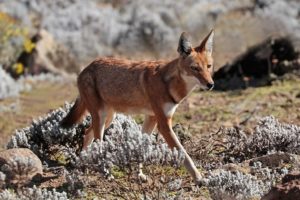 The Ethiopian wolf is the world’s rarest canid and Africa’s most threatened carnivore. The species is a close relative of gray wolves and coyotes that colonized the Horn of Africa through land bridges. Ethiopian wolves are slender and long-legged with a distinctive red-tinged coat and bushy tail. Sadly, the species suffers from habitat loss, disease, and persecution, and fewer than 500 individuals remain in small, scattered, human-dominated mountain regions in Ethiopia.
The Ethiopian wolf is the world’s rarest canid and Africa’s most threatened carnivore. The species is a close relative of gray wolves and coyotes that colonized the Horn of Africa through land bridges. Ethiopian wolves are slender and long-legged with a distinctive red-tinged coat and bushy tail. Sadly, the species suffers from habitat loss, disease, and persecution, and fewer than 500 individuals remain in small, scattered, human-dominated mountain regions in Ethiopia.
Born Free has pledged to support the Ethiopian wolf’s long-term viability through the Ethiopian Wolf Conservation Programme (EWCP). EWCP takes a successful, multi-faceted approach to conservation, addressing individual animal protection, strengthening communities, preserving habitat, and promoting appreciation of this national treasure.
Learn more about Ethiopian wolves »
“Unless we step in and vaccinate, the impact is dire. You lose three out of four wolves in the affected population.”
Claudio Sillero, conservation biologist and founder of the Ethiopian Wolf Conservation Programme (EWCP)
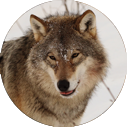
Wolves
Status
IUCN Red List classification:
Gray wolf: Least Concern. The gray wolf’s relatively widespread range and stable population trend mean that the species, at a global level, does not nearly meet any of the criteria for the threatened categories. However, at the regional level, several wolf populations are seriously threatened, including some of the reintroduced populations in North America and the Western-Central Alps population (which is actually classified as Endangered).
Ethiopian wolf: Endangered
CITES status:
Gray wolf: Wolves (which include the common names gray wolf and timber wolf) are included in CITES Appendix II, except wolf populations from Bhutan, India, Nepal, and Pakistan, which are listed on Appendix I.
Ethiopian wolf: The species is not included on the CITES Appendices. However, it has full official protection under Ethiopia's Wildlife Conservation Regulations of 1974, Schedule VI.
Endangered Species Act status:
Gray wolf: Endangered.
Ethiopian wold: Endangered.
Population
Estimated number remaining in the wild:
Gray wolf: Approximately 12,000-16,200 total in North America. There are around 7,000-11,200 gray wolves in Alaska, and an estimated 5,000 in the lower 48 states (3,700 in the Great Lakes region and 1,675 in the Northern Rockies).
Ethiopian wolf: Fewer than 500.
Population decline of wolves:
Gray wolf: Before widespread settlement over North America, an estimated 400,000 gray wolves roamed the landscape. Today, only approximately 12,000-16,200 remain on the continent.
Ethiopian wolf: Experts believe that there were probably only ever a few thousand Ethiopian wolves, at best, due to their limited habitat. Today, fewer than 500 individuals have survived.
Location
Gray wolf: Originally, the gray wolf was the world's most widely distributed mammal. Gray wolves were once common throughout all of North America, but were exterminated in most areas of the U.S. by the mid-1930s. The gray wolf’s original worldwide range has been reduced by about one-third, and it has become extinct in much of Western Europe, Mexico, and most of the U.S. Today, its range only includes Canada, Alaska, the Great Lakes, the northern Rockies, and the Pacific Northwest (in North America) and populations also survive in Europe and Asia. Thanks to the reintroduction of wolves in 1995, Yellowstone National Park is one of the most favored places to see and hear wolves in their native habitat.
Ethiopian wolf: Ethiopian wolves are only found on the highlands of Ethiopia, on half a dozen mountain ranges at high altitudes. Over half of the global population is found in the Bale Mountains.
Size
Gray wolf: Gray wolves are 26-32 inches at the shoulder, 4.5-6.5 feet in length from nose to tail-tip, and 40-175 pounds. Males are typically heavier and taller than the females.
Ethiopian wolf: Ethiopian wolves are 21-24 inches tall, up to about 3 feet in length, and about 24-42 pounds.
Fun Facts
Unlike other animals, wolves have a variety of distinctive facial expressions they use to communicate and maintain pack unity. Wolves are one of the few animals that communicate using a great range of facial expressions.
Wolves have superb endurance. A wolf can travel at a speed of 5 mph for up to 124.2 miles (200 km) in 24 hours.
Wolves run on their toes, which helps them to stop and turn quickly and to prevent their paw pads from wearing down.
Gray wolves were one of the first animals to be placed on the U.S. Endangered Species Act list in 1973.
A single wolf howl can be heard up to 6.2 miles (10 km).
